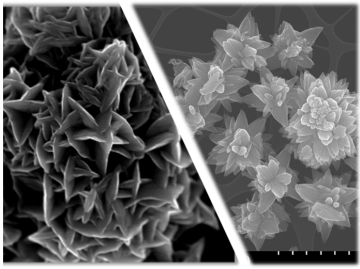Flame Synthesis & Functional Nanomaterials Lab
The Laboratory of Flame Synthesis and Functional Nanomaterials is an interdisciplinary team of scientists and engineers within the Chair of Dispersed Systems Engineering at the Faculty of Chemical and Process Engineering, Warsaw University of Technology. Our work focuses on the development of innovative nanomaterials with advanced chemical, physical, and structural properties.
Our mission is to foster environmentally friendly technologies that support sustainable development and offer cutting-edge solutions for the energy, chemical, and environmental sectors. We apply modern synthesis and characterization techniques to design novel nanostructures with unique and tailored functionalities.
Research staff
| Name and Surname | Room | Telephone | |
|---|---|---|---|
| Jabłczyńska Katarzyna, dr inż. | 302 | 22 234 62 76 | Katarzyna.Jablczynska@pw.edu.pl |
| Werner Łukasz, dr inż. | 315 | Lukasz.Werner@pw.edu.pl | |
| Czelej Kamil, dr inż. | 301 | 22 234 62 09 | Kamil.Czelej@pw.edu.pl |
| Ćwieka Karol, dr inż. | 301 | 22 234 62 09 | Karol.Cwieka@pw.edu.pl |
Research Areas
Synthesis of Functional Nanomaterials
The development of nanomaterial synthesis methods lies at the core of our research. We specialize in:
- Flame synthesis of composite nanoparticles
- Design and synthesis of nanomaterials with tailored optical and catalytic properties
- Surface modification of nanostructures to enhance their functionality
Our state-of-the-art Particle Technology Laboratory is equipped with advanced flame synthesis systems, enabling precise control over particle size, shape, and composition.
Our current focus is on titanium dioxide (TiO₂)- and rhenium (Re)-based nanomaterials, which show great potential for use in advanced photocatalytic processes.
Photocatalysis in Environmental Protection
One of the key challenges in modern science and technology is improving water and air quality. Our team develops advanced composite photocatalysts based on ZnO nanorods and rhenium disulfide (ReS₂) nanoparticles. These structures exhibit high photostability and efficient photon-to-chemical energy conversion, opening up new opportunities for applications in water remediation technologies, including the degradation of pharmaceutical contaminants.
We also design hybrid three-dimensional scaffolds based on nonwoven fabrics containing photocatalytically active nanoparticles immobilized on fiber surfaces. These materials enable the upscaling of the technology for industrial applications.
Advanced Modeling and Design of Nanomaterials
The development of modern nanomaterials requires not only experimental work but also precise modeling of their properties at the atomic level. Our team applies advanced theoretical approaches, including:
- Density Functional Theory (DFT)
- Finite-Difference Time-Domain (FDTD) computational methods
- Structural and molecular dynamics simulations
Using these tools, we design core–shell nanophotocatalysts that exhibit exceptional catalytic activity. We focus particularly on harnessing localized surface plasmon resonance (LSPR) to enhance light-driven chemical reactions.
Our interdisciplinary approach, advanced research techniques, and close collaboration with industry enable our projects to make a real impact on the development of 21st-century technologies. Through our research, we contribute to the creation of more efficient and sustainable solutions with the potential to transform the way we produce and use energy.
We invite you to collaborate with us and follow our research!
Selected Publications:
- Embedding Pd into SnO2 drastically enhances gas sensing, Jabłczyńska Katarzyna, Gogos Alexander, Kubsch Christian M. P., Sotiris E. Pratsinis [i in.], Nanoscale Advances, 2024, vol. 6, nr 4, s.1259-1268, DOI:10.1039/d3na00558e
- Zero carbon footprint hydrogen generation by photoreforming of methanol over Cu/TiO2 nanocatalyst, Ćwieka Karol, Bojarska Zuzanna, Czelej Kamil, Leon Gradoń [i in.], Chemical Engineering Journal, 2023, vol. 474, s.1-11, Numer artykułu:145687. Przejdź do dokumentu po identyfikatorze cyfrowym DOI:10.1016/j.cej.2023.145687
- Formation of ReS2/ReO3 semiconductor-metal heterostructure boosts electrocatalytic performance of pristine ReS2 nanoparticles in hydrogen evolution reaction, Łukasz Werner, Zuzanna Bojarska, Marta Mazurkiewicz-Pawlicka, Kamil Czelej, Bogusław Mierzwa, Łukasz Makowski, Applied Materials Today, 2023, vol. 32, s.1-12, Numer artykułu:101781, DOI:10.1016/j.apmt.2023.101781
- Functionalized zinc oxide nanorods – polypropylene nonwoven composite with high biological and photocatalytic activity, Werner Łukasz, Nowak Bartosz, Rafał L. Górny [i in.], Journal of Environmental Chemical Engineering, 2023, vol. 11, nr 5, s.1-21, Numer artykułu:111079. DOI:10.1016/j.jece.2023.111079
- Supported plasmonic nanocatalysts for hydrogen production by wet and dry photoreforming of biomass and biogas derived compounds: Recent progress and future perspectives, Karol Ćwieka, Kamil Czelej, Juan Carlos Colmenares, Katarzyna Jabłczyńska, Łukasz Werner, Leon Gradoń, Chemcatchem, 2021, vol. 13, nr 21, s.4458-4496. DOI:10.1002/cctc.202101006
- Sustainable hydrogen production by plasmonic thermophotocatalysis, Czelej Kamil, Colmenares Juan Carlos, Jabłczyńska Katarzyna, Karol Ćwieka, Łukasz Werner, Leon Gradoń, Catalysis Today, 2021, vol. 380, s.156-186, DOI:10.1016/j.cattod.2021.02.004




